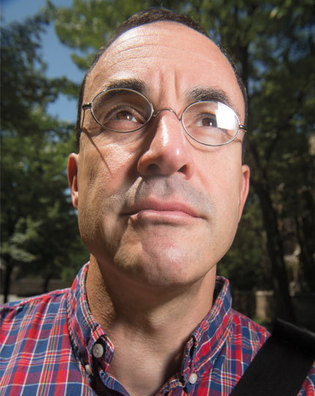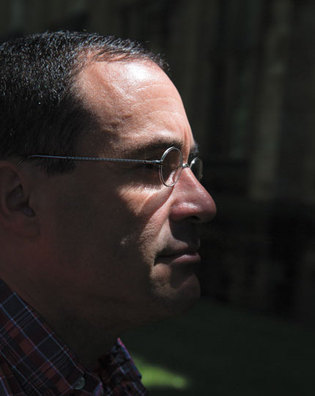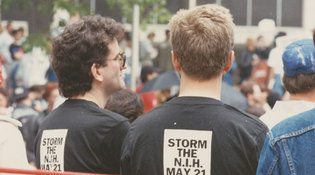 loading
loading
featuresIt’s not just the germsVeteran AIDS activist Gregg Gonsalves wants to change the way you think about illness. Cathy Shufro, a writing tutor at Yale, is a past fellow of the International Reporting Project at Johns Hopkins.  Mark OstowGregg Gonsalves ’11, who codirects an inter-disciplinary program at Yale on public health, brings to the work a rare level of experience in national health policy-making and personal knowledge of epidemics. View full imageAfter a single Guinean toddler got sick with Ebola in December 2013, the infection spread to as many as 28,000 people in West Africa. When four people in the United States came down with Ebola, they were isolated and treated—and the disease stopped there. Same virus; very different social and economic conditions. Those latter factors made all the difference, says Gregg Gonsalves ’11, and epidemics such as Ebola will recur and recur, “unless we start looking at the root causes that drive health disparities—in other words, why some of us get sick.” The 51-year-old Gonsalves, a graduate student at Yale, codirects Yale’s Global Health Justice Partnership—a program of Yale’s law and public health schools that guides students in studying how politics, law, human rights, governance, and economics interact with variations in public health and medical care to cause widespread disease. Students come to recognize, he says, that a single principle underlies the spread of Ebola, HIV, tuberculosis, polio, and maladies not yet imagined: “Infectious diseases will always be with us, but epidemics are human creations.” It’s rare for a grad student to codirect an interdisciplinary program at Yale, or to be appointed a Yale Law School lecturer, as Gonsalves has been. But he comes to this field of scholarship with qualifications that very few grad students have attained—including firsthand experience of national health policy-making and personal knowledge of the trauma and inequity of epidemics. In 1989, Gonsalves was supporting himself by waiting tables in Cambridge, Massachusetts, when his new boyfriend stopped by and tearfully announced that he was HIV positive. Gonsalves hadn’t known anyone with HIV until that day. He and his boyfriend wanted more information, and Gonsalves discovered ACT UP, a group fighting for quicker drug development, better care for the sick, and better prevention for the healthy. He would spend the next 26 years as an AIDS activist. He’d already come out to his parents. The son of a guidance counselor and an English teacher, and the grandson of immigrants from Portugal and Italy, he had been raised on Long Island in a Catholic household. He was a sophomore at Tufts University when he told his parents he was gay. They insisted that he see a psychiatrist, and he insisted that they go with him. At the end of the session, he recounts, the psychiatrist turned to his parents: “He puts down his glasses, and he says, ‘It seems like Gregg is fine with this. Perhaps you two would like to come back again.’” Gonsalves had expected to become a doctor, a plan grounded in an interest in science and a vague sense of wanting to help people. “And then I took a poetry class, and that changed everything.” He immersed himself in English and Russian literature. Then, during his sophomore year, he fell ill with mono, his favorite uncle died, and he became depressed. He dropped out and soon found that “the outside world was much more intriguing than the university.” That was in the early 1980s, not long after American doctors had first noticed unusual cancers and infections in a few gay men. When Gonsalves joined ACT UP in 1989, the disease still remained virtually untreatable, and ACT UP members had taken their frustration to the streets. Gonsalves and a few others became autodidacts, studying the science of AIDS so that they could monitor taxpayer-funded research and perhaps hasten it. The scientists working to develop treatments mistrusted the activists. “There was real hostility initially to opening up the management of clinical trials to non-experts and patients,” says Gonsalves. Things changed on the day in May 1990 that a thousand protesters stormed the campus of the National Institutes of Health (NIH) in Bethesda, Maryland. While police arrested busloads of demonstrators, Anthony S. Fauci, the head of the National Institute of Allergy and Infectious Diseases, did something unforeseen: he invited a delegation inside. In the months and years following, NIH brought the activists into its research meetings. “We’re banging on the door to get a seat at the table,” Gonsalves recalls, “and all of a sudden the door opens.” Gonsalves joined meetings of immunologists, statisticians, virologists, and others, helping, for instance, to shape clinical trial protocols and to decide how federally funded AIDS research would proceed. Those meetings convinced him and his fellow activists that NIH was mismanaging its billion-dollar research budget. They needed data to back up their claim, so Gonsalves and his friend Mark Harrington talked to researchers and read thousands and thousands of pages of abstracts, grants, and contracts—one for every grant and contract funded by NIH. “And we found out there were a lot of gaps and redundancies.” They publicly demanded that NIH revamp its system for coordinating AIDS research and called for an independent full-time director to replace Fauci—the very person who had invited them to the table—as director of the Office of AIDS Research.  Mark OstowGonsalves wants his students to understand that health “is not just about pills into bodies.” View full imageThe federal NIH Authorization Act incorporated their demands. Two decades later, Fauci bears no grudge. The activists “were very positive people,” he says. “We didn’t always agree, but their participation transformed how we did clinical trials.” One innovation, at the Food and Drug Administration, was to create a “parallel track” for drug testing, allowing HIV-positive people to try promising but unproven drugs even if they didn’t qualify for a clinical trial. Another FDA step shortened the timeline for clinical trials by allowing researchers to evaluate success by biological markers, like immune-cell counts, rather than longer-term clinical outcomes such as lifespan. As for Gonsalves, Fauci describes him as part of the “intelligentsia” of AIDS. In addition to advising NIH, Gonsalves served on committees at the FDA and the World Health Organization. At the first White House Conference on AIDS in 1995, his colleagues chose him to brief President Bill Clinton on the status of AIDS research. By 1996, after researchers had finished crucial studies, revolutionary new drugs were accessible that would save the lives of countless AIDS patients. But by then, the epidemic had burgeoned worldwide. Beginning in 2000, Gonsalves began working to get the new combination drugs to HIV-positive people beyond North America and Europe. One “co-conspirator,” he says, was Harvard’s Jim Yong Kim, who would soon lead the HIV/AIDS department at the World Health Organization. (Kim is now the World Bank president.) WHO pushed governments in developing countries to swiftly expand AIDS treatment. Between 2000 and 2007, the number of people getting the new medications increased from several hundred thousand to 3 million worldwide. “That’s the global health equivalent of going from zero to 60 in 30 seconds,” says Gonsalves. At age 44, after two years training AIDS educators and activists in southern Africa, Gonsalves decided to complete some “unfinished business”: getting his college degree. He heard about Yale’s Eli Whitney Students Program, which allows people who have taken an unusual path to college to immerse themselves in campus life, and he came to New Haven in 2008 with his partner, Jeff Hoover, an editor and writer.  Steven KeirsteadGonsalves (fourth from right) and other ACT UP activists prepared for a demonstration at the State House in Boston to confront then-governor Michael Dukakis about cuts to AIDS funding in the Massachusetts budget. View full image Office of NIH History and Stetten MuseumAIDS activists wearing T-shirts for the May 1990 protest at the National Institutes of Health. View full imageYale has had an interdisciplinary program in AIDS research since 1997, and one of the first effective AIDS drugs was invented at Yale. (At the instigation of activists, faculty, and students, it later became one of the first AIDS drugs available in Africa at low cost.) But Gonsalves came to Yale to explore other intellectual areas. He completed his college degree in ecology and evolutionary biology, with Professor Stephen Stearns ’67 as his mentor. “I do not think I have ever had a student who was more motivated to learn,” says Stearns. “His 20 years in the trenches of AIDS activism and his own brush with death—he is HIV positive—produced a mindset that may resemble that of returning World War II veterans: I have nothing to lose, and I am just going to go for it.” After Gonsalves graduated in 2011, friends on the Yale faculty urged him to stay at Yale. He’s now a graduate student in public health. His doctoral work centers on how to use quantitative methods to improve the efficiency and the outcomes of health programs. He coauthored a paper, published in April in the science journal PLOS ONE, that used mathematical models to estimate that doubling the number of toilets in an impoverished South African township would cut by 30 percent the sexual assaults suffered by women walking to toilets alone. Quite simply, if women don’t have to walk as far, they are less likely to be raped. These days, Gonsalves doesn’t look much older in person than he does in How to Survive a Plague, a documentary about ACT UP that shows archival footage of him in his early 30s. Kept alive by the drugs he helped to push for, he keeps his black hair short and wears oval steel-rimmed glasses. He dresses in Old Navy sweaters and khaki cargo pants. “A 50-year-old should not be wearing cargo pants, but I just like the pockets,” he says. Gonsalves remains the complicated hybrid he’s been since ACT UP, when he was an adviser to NIH and also an activist shouting in the streets: both insider and outsider. When he applied to Yale, he got letters of recommendation from Fauci, Kim, and Yale medical school professor Gerald Friedland. When Gonsalves and Hoover married in 2011, Yale president-to-be Peter Salovey ’86PhD officiated. Gonsalves feels grateful to Yale “for giving me a second chance on an undergraduate education—and with full financial aid.” On the other hand, he’s uneasy when, he says, some faculty and students tout Yale for providing a sort of “union card” to join the elite. That’s “a cramped vision of what the university is supposed to be about. I wish there was more attention to understanding how to be a good citizen, a decent human being.” But he also sees “a rich tradition” showing that “Yale can be a force for good.” In public health and other humanitarian fields, “we can use research and informed analysis to push these issues along, and we can do this in collaboration with advocates and activists.” It was during the summer before he entered grad school that Gonsalves cofounded the Global Health Justice Partnership with Amy Kapczynski ’03JD, a professor at the Law School, and Alice Miller, an assistant clinical professor at the School of Public Health. The partnership helps train young people to understand public health broadly. Since spring 2013, the project has brought together dozens of students from law, public health, forestry, medicine, business, and global affairs, who work together looking for social solutions to public health problems. The partnership offers a course in which students meet weekly to do research and devise practical strategies to solve the problems they address. In spring 2015, the class considered ways to make treatment affordable for the 185 million people worldwide with Hepatitis C, a potentially fatal infection that damages the liver. The full price for a cure now stands at $84,000. A previous project looked at how the denial of compensation to sick gold miners in South Africa has contributed to poverty. The class learned that a half million black former miners are estimated to have silicosis, a lung disease that miners get from breathing dust underground. A century-old law requires compensation for the miners or their survivors, but, according to a 2003 audit, the South African government rejects 99 percent of miners’ claims. Moreover, silicosis contributes to South Africa’s tuberculosis epidemic: it doubles the likelihood that a mineworker will develop TB, the country’s leading cause of natural death. Through their work, Gonsalves says, the students raised the issue of the missing compensation “from the backwaters of policy discussion into the international arena.” Like all the projects, he adds, this one “requires looking at a health problem and looking for how other factors—political, legal, social, and cultural reasons—make people’s bodies vulnerable. What’s allowing the silicosis and the bacillus to run rampant among miners in South Africa?” Answering that question requires “diagnosing and treating the body politic,” Gonsalves argues. “If students are really committed to global health and to helping the poor, it means they are going to have to act up. Health is not just about pills into bodies.” The Global Health Justice Partnership is more than an academic enterprise, he adds. He and Kapczynski and Miller have a broader goal: “training the next generation of activist-scholars.”
|
|
5 comments
-

Suzanne Benzer, 11:02pm September 12 2015 |  Flag as inappropriate
Flag as inappropriate
-

Timothy Lunceford-Stevens, 11:59pm September 12 2015 |  Flag as inappropriate
Flag as inappropriate
-

Richard Stern, 1:45am September 13 2015 |  Flag as inappropriate
Flag as inappropriate
-

Charlie van der Horst, 4:57am September 13 2015 |  Flag as inappropriate
Flag as inappropriate
-

David Barr, 6:03pm September 13 2015 |  Flag as inappropriate
Flag as inappropriate
The comment period has expired.I met Gregg in the early 90's. He was among the young men and women that I had the privilege of knowing and working with during the height of the AIDS activism.
My son had been infected while at college and Gregg was one of the people that taught me how to channel my rage in a constructive manner to bring about change. He had a wonderful gentle quality about him and I remember him so well.
It has been many years since we've seen each other. I am so proud of the man that he has become.
.
I enjoyed working with Gregg in ACTUPNY with Treatment and Data and later when we moved on to form Treatment Action Group with other T&D members. Gregg's attention to detail was surely a great help then. I know with his drive to excellence, that going to Yale to finish his degree would lead to remarkable change. It has and the projects he has developed with others does help society at large become with better health. Keep up the good work Gregg.
Excellent article....your collaboration in supporting treatment access activism in Latin America was unconditional and effective. Getting generic meds acepted in Latin America was very much the result of the work of Health Gap people, including yourself. Luckily a few local PLWA overcame the popular rejection of generics, (fueled by false horror stories spread by multinationals) and later on UNAIDS and PAHO began to give important support as well which helped to legitimize generics. But you were the ones who spread the word first. The battle is still going on here, with the newer ARV medications often patented and therefore out of reach economically of local health care systems. The result of free trade agreements, as well as the reluctance to use compulsory licenses. Argentina is a recent exception and I hope other countries will follow suit. But in Costa Rica ATRIPLA for example is patented and the Health care system refuses to pay the asking price. Actually in Costa Rica there is still only one combination treatment, which is two ARVs and not three. So current cocktails are "out-dated", as in most of Central America. Anyway, again congratulations on your incredible succeses at Yale.
Wonderful article about a wonderful person.
In the photo with the activists preparing for the action in Boston, I believe that Gregg is second from the right, not fourth as the captions says.